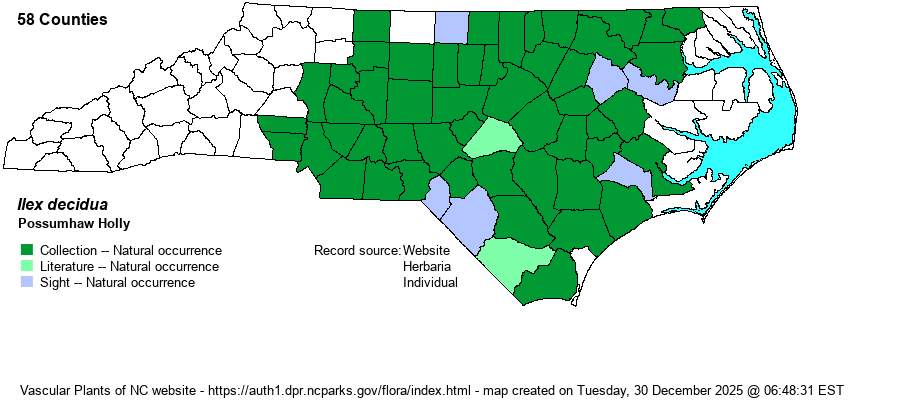| Author | Walter | |
| Distribution | Throughout the eastern and central Piedmont, but scarce to absent in the western/foothills part of the province. Also throughout most of the Coastal Plain, but scarce to absent in the far eastern counties. Apparently absent in the Mountains.
This is a Southern species ranging north only to MD, IL, and southeastern KS; it reaches south to southern FL and central TX. However, it is absent to scarce in the Appalachian and Cumberland mountains and the Ridge and Valley province.
| |
| Abundance | Common and widespread in the Piedmont part of the range. Common in the northwestern third of the Coastal Plain, but only fairly common at best in the southern Coastal Plain, including the Sandhills. Very rare to rare in the far eastern Coastal Plain, and western portions of the Piedmont. | |
| Habitat | This is an easily found species of many or most Piedmont bottomlands and brownwater bottomlands of the Coastal Plain. It also occurs along wooded stream banks, in mesic forests, and at times in moderately dry forests on slopes – but not in sandy or rocky soils or in overly acidic soil conditions. It can occur in swamps, but more so in the drier portions; it can occur at pools in floodplains and in wet thickets. |
| Phenology | Blooms from March to May, and fruits from September to October, and at times persisting into winter. | |
| Identification | This is a large deciduous shrub or small tree, growing to about 15 feet tall and occasionally to at least 25 feet tall. It has alternate leaves that are differently-shaped from other hollies; they are oblanceolate (widest above the middle) to nearly diamond-shaped with tapering bases and some scattered blunt serrations on the outer half of the leaf. The leaves are thin and dull above, are about 2-2.5 inches long, and at times are clustered on spurs branches rather than evenly spread out along the branches. Normally, one should be able to identify the species from the leaves, but by fall the bright red “berries” become visible and then clearly denote the species in the forest. In fact, when you are walking through a forest in late fall and early winter, after leaves on most trees have fallen, a shrub or tree with red “berries” on bare stems is usually this species. | |
| Taxonomic Comments | There are no issues with this being a valid species. However, other taxa have been included in this species in the past and now. Formerly, Ilex longipes was included in this species as I. decidua var. longipes (e.g., RAB 1968).
| |
| Other Common Name(s) | Deciduous Holly, Possum-haw. Note: “Possum-haw”, “Possumhaw”, or “Possum Haw” is the most frequently used name. However, other shrubs or small trees are also called “haw”, including several Viburnum species; in fact, V. nudum is often called Possumhaw Viburnum, as is done on this website. Thus, it is important to avoid confusion and add “Holly” after “Possumhaw” for Ilex decidua, as some websites and references do, including this one. | |
| State Rank | S5 | |
| Global Rank | G5 | |
| State Status | | |
| US Status | | |
| USACE-agcp | FACW link |
| USACE-emp | FACW link |

